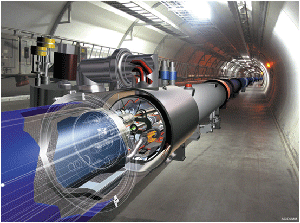CERN - European Organization for Nuclear Research logo.
Sept. 4, 2018
The most powerful particle accelerator in the world has made it possible to confirm the existence of the Higgs boson.
On 10 September 2008, the Large Hadron Collider (LHC) was started at CERN. The physicists had at the time placed a lot of hopes in this formidable machine to dissect the matter. Ten years later, they can say they are satisfied.
The most powerful particle accelerator in the world has allowed to confirm experimentally, in 2012, the existence of the Higgs boson. Elusive until then, this boson was only deduced from the theory. It explains why subatomic particles have a mass and why others do not have one.
Large Hadron Collider (LHC). Image Credit: CERN
This discovery was a big step forward in understanding the infinitely small and supported the standard model of particle physics, the theory describing particles and their interactions. Physicists have not yet had to change all their plans to adapt to a new reality.
Even though Higgs bunching has been a priority mission for the LHC, the accelerator also allows other advances in areas worthy of a science fiction series. Experiments are thus conducted on the mysterious dark matter, the properties of antimatter, the search for hidden dimensions.
A jewel of technology
The LHC is not only one of the most extraordinary machines ever built. The particle accelerator also represents an extraordinary technological feat. Buried 100 meters underground, the 27-kilometer ring is lined with powerful magnets charged with guiding beams of protons and ions.
The tube is cooled to minus 271 degrees Celsius, 2 degrees more than the absolute zero, so that the magnets can operate in the state of superconducting. It is in this freezer that the collisions between protons occur, at energies that had never before reached an accelerator.
Large Hadron Collider (LHC). Animation Credit: CERN
In a first phase of operation of the LHC, the protons clashed at 7 TeV (teraelectronvolt). In 2015, collision energy gradually increased to 13 TeV. By 2021, this value will even be increased to 14 TeV, the maximum capacity of the machine.
At such levels of energy, scientists go on to explore unknown lands, and surprises could await them, pushing them to radically change their worldview. The LHC's competitors do not come close to it in this area. Thus, the Fermilab of Chicago reaches 2 TeV.
Already after
The LHC is scheduled to run until 2040. By that time the accelerator will undergo a large moult to significantly increase the number of proton collisions it produces. Currently, the number of collisions is 1 billion per second. In 2026, this figure will be multiplied by five.
CERN - Actual configuration. Image Credit: Phillipe Mouche.
Scientists will have more data to analyze and more likely to come across new events. Particles still invisible today could be detected with the improved machine. The Higgs boson can also be better studied because it will be produced in larger quantities.
Building a machine such as the LHC takes time and especially anticipation. Thus, CERN is already thinking of the successor of the Large Hadron Collider. It would be an accelerator of 100 kilometers in circumference. It would be located astride the Franco-Swiss border, as is the LHC.
Note:
CERN, the European Organization for Nuclear Research, is one of the world’s largest and most respected centres for scientific research. Its business is fundamental physics, finding out what the Universe is made of and how it works. At CERN, the world’s largest and most complex scientific instruments are used to study the basic constituents of matter — the fundamental particles. By studying what happens when these particles collide, physicists learn about the laws of Nature.
The instruments used at CERN are particle accelerators and detectors. Accelerators boost beams of particles to high energies before they are made to collide with each other or with stationary targets. Detectors observe and record the results of these collisions.
Founded in 1954, the CERN Laboratory sits astride the Franco–Swiss border near Geneva. It was one of Europe’s first joint ventures and now has 22 Member States.
Related link:
Large Hadron Collider (LHC): https://home.cern/topics/large-hadron-collider
For more information about European Organization for Nuclear Research (CERN), Visit: https://home.cern/
Images (mentioned), Animation (mentioned), Text, Credits: CERN/ATS/Orbiter.ch Aerospace/Roland Berga.
Best regards, Orbiter.ch




